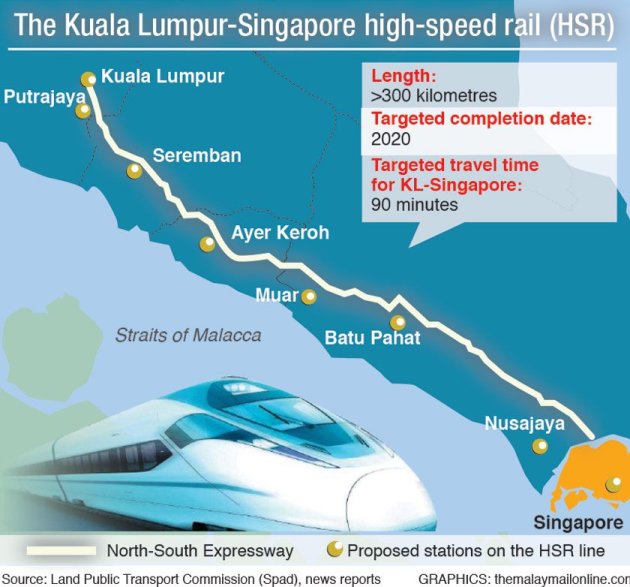
Kuala Lumpur-Singapore HSR project that will stretch over 300 km, there will be eight stops — Putrajaya; Kuala Lumpur; Negri Sembilan’s Seremban; Malacca’s Ayer Keroh; Johor’s Muar, Batu Pahat, Nusajaya; and then Singapore itself.
During a recent Malaysian media visit, an official from Japan’s Ministry of Land, Infrastructure, Transport and Tourism (MLIT) said the economic impact from building bullet train systems would depend on the volume of passengers.
“The economic effect differs depending on the number of passengers, the Malaysian government has not released the result of their research,” a senior officer attached to MLIT’s railway bureau told Malaysian reporters on condition of anonymity.
He said Japan would be unable to calculate the figures for Malaysia without Putrajaya’s ridership projection.
In Japan, where the country’s entire population is at least four times larger than Malaysia’s 30 million and over 20 times larger than Singapore’s 5.47 million, the Shinkansen now carries 350 million passengers annually.
Japan believes that the Kuala Lumpur-Singapore HSR is an ideal project with its distance of below 350 km, as 2010 statistics show over 90 per cent of passengers opting for the Shinkansen over flying and travelling by road for the Tokyo-Nagoya (342km) and Tokyo-Sendai routes (325km).
Once the distance stretches too far — typically beyond 900km — the ridership and market share for Shinkansen trains drop as flying becomes the more time-effective way to travel.
While an airplane can take you between Kuala Lumpur and Singapore in an hour’s time, add on the travelling time to airports and boarding time and it easily uses up a few hours of your schedule.
Airports also tend to be built on the outskirts of cities unlike the Shinkansen model, where one can easily hop on and off a bullet train from stations located right smack in the city centre, saving precious minutes for those rushing to urgent business meetings or for tourists itching to start their tour.
An example of how seamless travel can be using the Shinkansen model is seen in how one can make an instant purchase on mobile devices and pass through automatic ticket gates, and then go on to the platform just two minutes before boarding time at the Tokyo Station. What’s not to like about that?
Could this be the gamechanger for travel between Malaysia and Singapore, for passengers who have always been forced to pit the costs against the travel time; pay less for a bus ride and face possible traffic congestion along the way, or pay more for a shorter travel period?
Footing and trimming the bill
While the economic benefits of a bullet train can be potentially enormous, the costs to build it can also be prohibitive, with Japan having funded its past Shinkansen lines largely through loans - which at one point led to the privatisation of Japanese National Railways (JNR).
Currently, both the central government and local governments in Japan pay the construction costs for new lines, while the Shinkansen’s private operators pay a lease fee for the railway tracks and get to keep the excess profits.
How much does it actually cost to have a Shinkansen lookalike in Malaysia?
News reports have previously projected it to be between US$8 billion to US$ 24 billion (RM28.8 billion to RM86.4 billion) and Prime Minister Datuk Seri Najib Razak reaffirmed that the project would still go on even as Putrajaya tightens its belt this year to save RM5.5 billion amid falling oil prices.
Costs can be trimmed in the KL-Singapore HSR project as the relatively disaster-free countries would not need earthquake-resistant technology like Japan.
Japan is touting ways in which its Shinkansen design can be more cost-effective than its competitors, including smaller tunnels and bridges, simple station layout — where hundreds of train trips per day can be operated within minimal space. The Tokyo Station, for example, can cater to 400 Shinkansen rides daily for JR East’s network on just two platforms and four tracks.
According to Shinkansen operator East Japan Railway Company (JR East)’s officials, the average lifespan of a bullet train in Japan is 16 to 20 years when it has been in operation for around 10 million kilometres, with new technology typically developed and kicking in by the end of such a period.
Who will win the bid?
While Japan has been eagerly courting Malaysia for the HSR, it is still unknown who will be chosen, with Malaysia having carried out studies and Singapore still carrying out feasibility studies.
Besides Japan, other countries like China, South Korea, Spain, France and Germany have reportedly offered their services and technology to Malaysia.
The tendering process has yet to start and financing details have yet to be announced, with Malaysia’s Prime Minister Datuk Seri Najib Razak mentioning a public-private partnership model when the HSR was first announced in February 2013 together with Singapore’s Prime Minister Lee Hsien Loong.




